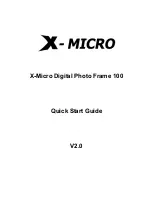
4
Do not directly edit the data on the memory card.
Copy the data to your PC before you edit them.
When the camera is stored for a long period of
time, be sure to download your photos and remove
the memory card. Store it in a dry environment.
Format the memory card using the camera before
you use it or insert a new one.
We suggest buying only well-known, name brand
memory cards to ensure peak performance.
Do not modify the name of the files or folders of
the memory card using your PC. Modifying the file
names may cause the files to not be recognized
on the camera or a possible error may occur.
A photo taken with the camera will be stored in the
folder that is automatically generated on the SD
card. Do not store photos that are not taken using
this camera in these folders as the pictures cannot
be recognized during the playback.
When you insert a memory card, make sure the
notch of the card matches the markings on the top
of the card slot.
Other Safety Notes
Do not disconnect the power or turn the camera off
during the update process. Doing so may cause
incorrect data to be written and the camera may
not power on later.
When using your camera on an airplane, observe
the relevant rules specified by the airline.
Due to the limitations of manufacturing technology,
the LCD screen may have a few dead or bright
pixels. These pixels do no effect the quality or
performance of the camera, photos or video.
Do not expose the LCD screen to water. In a humid
environment, only wipe it with a soft and dry clean-
ing cloth.
If the LCD screen is damaged and the liquid crys-
tal comes into contact with your skin, wipe your
skin with a dry cloth immediately and rinse it with
clean water. If liquid crystal comes into contact
with your eyes, wash them with clean water at
least for 5 minutes and seek immediate medical
attention. If you accidentally swallow liquid crystal,
rinse your mouth immediately and seek medical
attention.






































